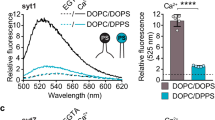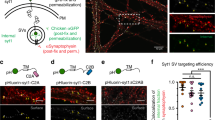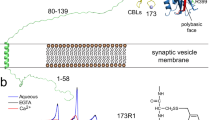Abstract
Exocytosis—the release of the contents of a vesicle—proceeds by two mechanisms1,2,3,4,5,6. Full fusion occurs when the vesicle and plasma membranes merge. Alternatively, in what is termed kiss-and-run, vesicles can release transmitter during transient contacts with the plasma membrane. Little is known at the molecular level about how the choice between these two pathways is regulated. Here we report amperometric recordings of catecholamine efflux through individual fusion pores. Transfection with synaptotagmin (Syt) IV increased the frequency and duration of kiss-and-run events, but left their amplitude unchanged. Endogenous Syt IV, induced by forskolin treatment, had a similar effect. Full fusion was inhibited by mutation of a Ca2+ ligand in the C2A domain of Syt I; kiss-and-run was inhibited by mutation of a homologous Ca2+ ligand in the C2B domain of Syt IV. The Ca2+ sensitivity for full fusion was 5-fold higher with Syt I than Syt IV, but for kiss-and-run the Ca2+ sensitivities differed by a factor of only two. Syt thus regulates the choice between full fusion and kiss-and-run, with Ca2+ binding to the C2A and C2B domains playing an important role in this choice.
This is a preview of subscription content, access via your institution
Access options
Subscribe to this journal
Receive 51 print issues and online access
$199.00 per year
only $3.90 per issue
Buy this article
- Purchase on Springer Link
- Instant access to full article PDF
Prices may be subject to local taxes which are calculated during checkout





Similar content being viewed by others
References
Neher, E. & Marty, A. Discrete changes of cell membrane capacitance observed under conditions of enhanced secretion in bovine adrenal chromaffin cells. Proc. Natl Acad. Sci. USA 79, 6712–6716 (1982)
Alvarez de Toledo, G., Fernandez-Chacon, R. & Fernandez, J. M. Release of secretory products during transient vesicle fusion. Nature 363, 554–558 (1993)
Klyachko, V. A. & Jackson, M. B. Capacitance steps and fusion pores of small and large-dense-core vesicles in nerve terminals. Nature 418, 89–92 (2002)
Schneider, S. W. Kiss and run mechanism in exocytosis. J. Membr. Biol. 181, 67–76 (2001)
Albillos, A. et al. The exocytotic event in chromaffin cells revealed by patch amperometry. Nature 389, 509–512 (1997)
Ales, E. et al. High calcium concentrations shift the mode of exocytosis to the kiss-and-run mechanism. Nature Cell Biol. 1, 40–44 (1999)
Chow, R. H., von Rüden, L. & Neher, E. Delay in vesicle fusion revealed by electrochemical monitoring of single secretory events in adrenal chromaffin cells. Nature 356, 60–63 (1992)
Schroeder, T. J. et al. Temporally resolved, independent stages of individual exocytotic secretion events. Biophys. J. 70, 1061–1068 (1996)
Wang, C.-T. et al. Synaptotagmin modulation of fusion pore kinetics in regulated exocytosis of dense-core vesicles. Science 294, 1111–1115 (2001)
Vician, L. et al. Synaptotagmin IV is an immediate early gene induced by depolarization in PC12 cells and in brain. Proc. Natl Acad. Sci. USA 92, 2164–2168 (1995)
Ferguson, G. D., Vician, L. & Hershman, H. R. Synaptotagmin IV: Biochemistry, genetics, behavior, and possible links to human psychiatric disease. Mol. Neurobiol. 23, 173–185 (2001)
Jackson, M. B. Stationary single channel analysis. Methods Enzymol. 207, 729–746 (1992)
Colquhoun, D. & Hawkes, A. G. On the stochastic properties of bursts of single ion channel openings and of clusters of bursts. Phil. Trans. R. Soc. Lond. B 300, 1–59 (1982)
Eaton, B. A., Haugwitz, M., Lau, D. & Moore, H.-P. H. Biogenesis of regulated exocytotic carriers in neuroendocrine cells. J. Neurosci. 20, 7334–7344 (2000)
von Poser, C., Ichtchenko, K., Shao, X., Rizo, J. & Sudhof, T. The evolutionary pressure to inactivate: A subclass of synaptotagmins with an amino acid substitution that abolishes Ca2+ binding. J. Biol. Chem. 272, 14314–14319 (1997)
Bai, J., Wang, P. & Chapman, E. R. C2A activates a cryptic Ca2+-triggered membrane penetration activity within the C2B domain of synaptotagmin I. Proc. Natl Acad. Sci. USA 99, 1665–1670 (2002)
Littleton, J. T., Serano, T. L., Rubin, G. M., Ganetzky, B. & Chapman, E. R. Synaptic function modulated by changes in the ratio of synaptotagmin I and IV. Nature 400, 757–760 (1999)
Chapman, E. R. Synaptotagmin: A Ca2+ sensor that triggers exocytosis? Nature Rev. Mol. Cell Biol. 3, 498–508 (2002)
Ubach, J., Zhang, X., Shao, X., Sudhof, T. C. & Rizo, J. Ca2+ binding to synaptotagmin: How many Ca2+ ions bind to the tip of a C2-domain? EMBO J. 17, 3921–3930 (1998)
Fernandez-Chacon, R. et al. Synaptotagmin I functions as a calcium regulator of release probability. Nature 410, 41–49 (2001)
Robinson, I. M., Ranjan, R. & Schwartz, T. L. Synaptotagmins I and IV promote transmitter release independently of Ca2+ in the C2A domain. Nature 418, 336–340 (2002)
Davis, A. F. et al. Kinetics of synaptotagmin responses to Ca2+ and assembly with the core SNARE complex onto membranes. Neuron 24, 363–376 (1999)
Klinglauf, J., Kavalali, E. T. & Tsien, R. W. Kinetics and regulation of fast endocytosis at hippocampal synapses. Nature 394, 581–585 (1998)
Stevens, C. F. & Williams, J. H. ‘Kiss and run’ exocytosis at hippocampal synapses. Proc. Natl Acad. Sci. USA 97, 12828–12833 (2000)
Cormack, B. in Current Protocols in Molecular Biology (eds Ausubel, F. M. et al.) 8.5.7–8.5.9 (Wiley, New York, 1994)
Klenchin, V. A., Kowalchyk, J. A. & Martin, T. F. J. Large dense-core vesicle exocytosis in PC12 cells. Methods 16, 204–208 (1998)
Chow, R. H. & von Rüden, L. in Single-Channel Recording (eds Sakmann, B. & Neher, E.) 245–275 (Plenum, New York, 1995)
Brose, N., Petrenko, A. G., Südhof, T. C. & Jahn, R. Synaptotagmin: A calcium sensor on the synaptic vesicle surface. Science 256, 1021–1025 (1992)
Acknowledgements
We thank L. A. Schuler for support and access to facilities; R. Jahn and S. Engers for antibodies against Syt I; R. Grishanin, C. A. Earles, J. A. Kowalchyk, and X. Han for discussions; and B. August of the University of Wisconsin Electron Microscopy Facility for performing electron microscopy. This work was supported by grants from the NIH to E.R.C., T.F.J.M. and M.B.J. E.R.C. is a Pew Scholar.
Author information
Authors and Affiliations
Corresponding author
Ethics declarations
Competing interests
The authors declare that they have no competing financial interests.
Supplementary information
Rights and permissions
About this article
Cite this article
Wang, CT., Lu, JC., Bai, J. et al. Different domains of synaptotagmin control the choice between kiss-and-run and full fusion. Nature 424, 943–947 (2003). https://doi.org/10.1038/nature01857
Received:
Accepted:
Issue Date:
DOI: https://doi.org/10.1038/nature01857
This article is cited by
-
Membrane transformations of fusion and budding
Nature Communications (2024)
-
Ketamine Inhibits ATP-Evoked Exocytotic Release of Brain-Derived Neurotrophic Factor from Vesicles in Cultured Rat Astrocytes
Molecular Neurobiology (2016)
-
Post-fusion structural changes and their roles in exocytosis and endocytosis of dense-core vesicles
Nature Communications (2014)
-
Synaptotagmin IV Acts as a Multi-Functional Regulator of Ca2+-Dependent Exocytosis
Neurochemical Research (2011)
-
Differential distribution of synaptotagmin-1, -4, -7, and -9 in rat adrenal chromaffin cells
Cell and Tissue Research (2011)
Comments
By submitting a comment you agree to abide by our Terms and Community Guidelines. If you find something abusive or that does not comply with our terms or guidelines please flag it as inappropriate.



